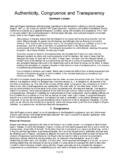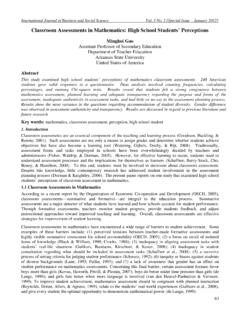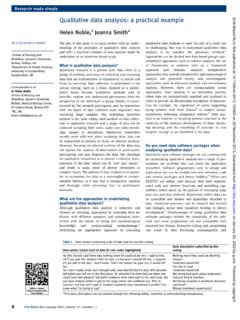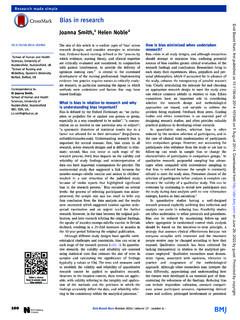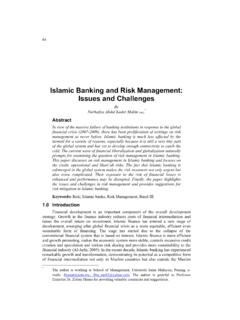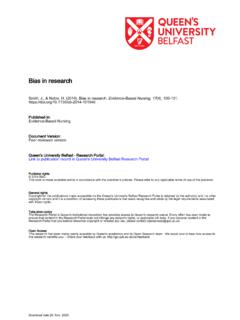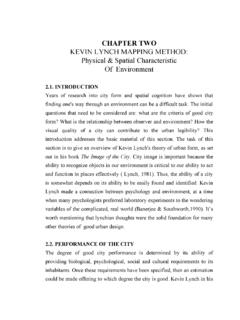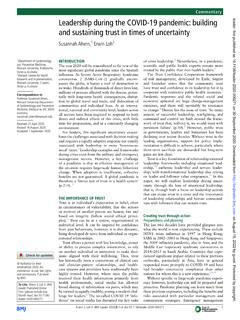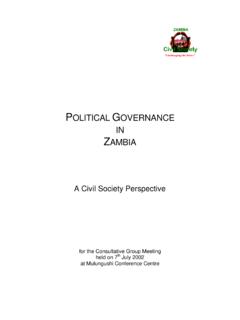Transcription of The impact of positivity and transparency on trust in ...
1 The impact of positivity and transparency on trust in leaders and theirperceived effectivenessSteven M. Normana, , Bruce J. Avoliob, Fred LuthansbaDepartment of Management, Colorado State University Pueblo, United StatesbUniversity of Nebraska Lincoln, Gallup Leadership Institute, Department of Management, University of Nebraska, United Statesarticle infoabstractA critical challenge facing today's organizational leaders is gaining their followers' trust andhaving them view leaders as effective in addressing turmoil and change. Using a downsizingscenario as the context, thisfield experiment examined how a leader's positivity andtransparency impacted followers' perceived trust , defined in terms of willingness to bevulnerable, and effectiveness of their leader. To test the hypotheses, 304 participants wererandomly assigned to one of the four conditions of high (low) leader positivity high (low)leader transparency .
2 Results of our mixed methods study indicated both the leader's level ofpositivity and transparency impacted followers' perceived trust and evaluations of leadereffectiveness. Besides limitations and suggestions for future research, we conclude with thepractical implications that positive, transparent leaders may have on building trust andperceived effectiveness among their followers. 2010 Elsevier Inc. All rights :Authentic leadershipPositivityTransparencyTrustDow nsizing1. IntroductionIn today's turbulent global environment too often characterized by prominent examples of unethical practices and the reality ofincreasingly frequent mergers, acquisitions and downsizing, followers' trust in their organizational leaders has become animportant issue. Prior leadership research has shown that how a leader acts and communicates with followers during verychallenging periods of time can create the foundation for future trust in the leader (Kasper-Fuehrer & Ashkanasy, 2001).
3 Specifically, the manner in which negative events such as layoffs or downsizing events are dealt with by leaders may directlyimpact followers' subsequent trust in their leaders (Korsgaard, Brodt, & Whitener, 2002; Tourish, Paulsen, Hobman, & Bordia,2004). Having trust in one's leader, in turn, has been tied to desirable performance outcomes such as satisfaction, retention,commitment, organizational citizenship behavior, and performance (Connell, Ferres, & Travaglione, 2003; Corbitt & Martz, 2003;Costa, 2003; Dirks & Ferrin, 2002).Through the use of a mixed methods design, this study examines how differing levels of positivity and communicationtransparency, within the context of a downsizing event, impacted participants' willingness to be vulnerable and place trust in thetarget leader and the leader's perceived effectiveness in addressing the downsizing situation.
4 Specifically, this study responds toearlier calls in the leadership literature and in a special issue published in this journal to begin empirically assessing how authenticleadership characterized by positivity and transparency (Avolio & Gardner, 2005; Avolio & Luthans, 2006; Luthans & Avolio, 2003)impacts key outcomes such as trust and Leadership Quarterly 21 (2010) 350 364 Corresponding author. Hasan School of Business, Colorado State University Pueblo, Pueblo, CO 81001, United States. Tel.: +1 719 549 Norman).1048-9843/$ see front matter 2010 Elsevier Inc. All rights lists available atScienceDirectThe Leadership Quarterlyjournal homepage: Theoretical Leader's positivityDrawn from the foundational work in positive psychology (Seligman & Csikszentmihalyi, 2000; Snyder & Lopez, 2002) andpositive organizational behavior (Luthans, 2002a,b; Nelson & Cooper, 2007; Wright, 2003; for a recent comprehensive review seeLuthans & Youssef, 2007), in this study a leader's positivity or positive psychological capacities was defined using the fourcomponents associated with positive psychological capital (Luthans, Avolio, Avey, & Norman, 2007; Luthans, Youssef, & Avolio,2007) and authentic leadership (Avolio & Luthans, 2006; Luthans & Avolio, 2003).
5 The four components include hope, resiliency,optimism and efficacy. Hope is defined as a positive motivational state that is based on an interactively derived sense of successful(a) agency (goal directed energy) and (b) pathways (planning to meet goals) (Snyder, Irving & Anderson, 1991, p. 287).Resiliency represents coping and adaptation in the face of significant adversity or risk (Masten & Reed, 2002), and has beenadapted to the workplace byLuthans (2002a, p. 702)as the positive psychological capacity to rebound, to bounce back fromadversity, uncertainty, conflict, failure, or even positive change, progress and increased responsibility. Optimism is an internal, relatively stable, and global attribution regarding positive events like goal attainment, and an external,relatively unstable, and specific cause for negative events such as not meeting a deadline (Seligman, 1998).
6 Realistic optimism hasbeen associated with having a positive future outlook, as well as making positive attributions regarding events that may beperceived by less optimistic individuals as inhibiting their motivation or performance (Luthans, 2002a; Schneider, 2001).Efficacy is the belief that one can execute actions required to successfully deal with prospective situations (Bandura, 1997). Applied to theworkplace,Stajkovic and Luthans (1998, p. 66)define efficacy as the conviction (or confidence) employees have about their ability tomobilize the motivation, cognitive resources or courses of action needed to successfully execute a specific task within a given context. These four positive psychological capacities when combined have been conceptually (Luthans, Youssef et al., 2007) andempirically (Luthans, Avolio, et al., 2007) shown to represent a higher-order, core construct and can be thought of as one's positivepsychological resources or capacities.
7 This core construct has been defined as an individual's positive psychological state ofdevelopment that is characterized by: (1) having confidence (self-efficacy) to take on and put in the necessary effort to succeed atchallenging tasks; (2) making a positive reference (optimism) about succeeding now and in the future; (3) persevering towardgoals and, when necessary, redirecting paths to goals (hope) in order to succeed; and (4) when beset by problems and adversity,sustaining and bouncing back and even beyond (resilience) to attain success (Luthans, Youssef, et al., 2007, p. 3).This higher-order positive capacity construct has an underlying commonality among the four dimensions representing apositive appraisal and belief in the situation, and available and/or potential psychological resources that can be used to attainsuccess through personal effort, striving, and perseverance.
8 Empirically, it has been shown that the four dimensions haveconvergent and discriminant validity in both the positive psychology ( ,Bryant & Cvengros, 2004; Carifio & Rhodes, 2002;Magaletta & Oliver, 1999) and workplace literature (Luthans, Avolio, et al., 2007). Evidence also indicates that when combined intoa core higher factor, it accounts for more variance in employee performance and satisfaction than each of the four individualcomponents (Luthans, Avolio, et al., 2007). Linkages to trustAlthough there is a growing body of research on trust , there are still differences of opinion on its definition (Connell et al.,2003). This study will examine trust by using the frequently cited definition that focuses on defining trust in terms of a willingnessto be vulnerable in one's relationship (Mayer, Davis, & Schoorman, 1995; Whitener, Brodt, Korsgaard, & Werner, 1998) withanother person based on positive expectations regarding that person's behavior (Rousseau, Sitkin, Burt, & Camerer, 1998).
9 Inherent in this definition is that trust also involves a willingness to be exposed to and take risks with that individual (Mayer et al.,1995). This definition of trust also includes an expectation that the individual who is being trusted is more predictable and/ordependable, and thus would be expected to be described as more trustworthy (Rousseau et al., 1998).One of the main goals of the current study is to examine how a leader's level of positivity as represented by expressed levels ofhope, resiliency, optimism and efficacy are related to participants' trust in that leader. trust has been previously associated with aleader's perceived ability, competence and performance (Driscoll, 1978; Mayer et al., 1995; McAllister, 1995; Scott, 1980).Specifically,Mayer and colleagues (1995)discussed three components of trustworthiness including competence, integrity andbenevolence.
10 We propose that a leader who displays higher levels of positivity (represented by hope, efficacy, optimism, andresiliency), would be seen by others as being more competent and in turn trustworthy because these components have beendemonstrated to be connected to higher levels of performance (Luthans, Avolio, et al., 2007).The ability of a leader to develop trust during a downsizing event has been shown to be directly related to the perceivedeffectiveness of that leader in successfully getting through adversity (Appelbaum, Everard, & Hung, 1999; Mishra, Spreitzer, &Mishra, 1998). Similarly, since one's competence and ability has been shown to be positively related to trust in that person byothers (Driscoll, 1978; Mayer et al., 1995; McAllister, 1995; Scott, 1980), leaders who are viewed as more effective should also beevaluated as being more trustworthy and more highly trusted.

